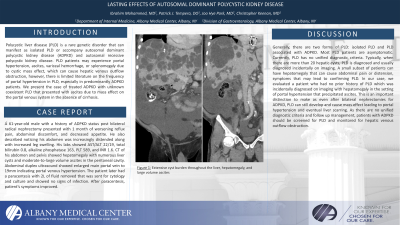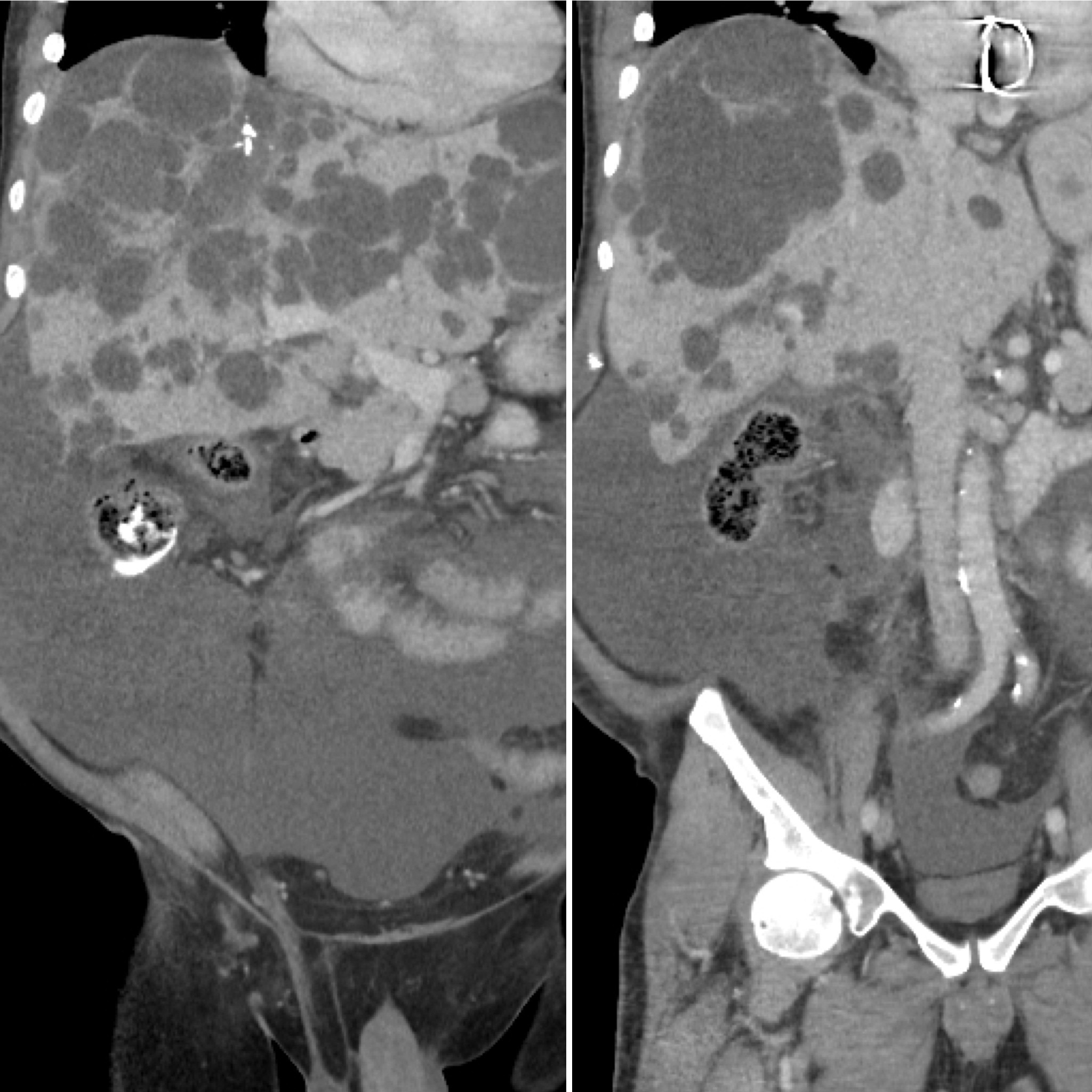Sunday Poster Session
Category: Liver
P1036 - Lasting Effects of Autosomal Dominant Polycystic Kidney Disease
Sunday, October 22, 2023
3:30 PM - 7:00 PM PT
Location: Exhibit Hall

Has Audio

Ibrahim Mohammed, MD
Albany Medical Center
Albany, NY
Presenting Author(s)
Ibrahim Mohammed, MD, Patrick J.. Tempera, DO, Joo Hye Park, MD, Christopher Keenan, MD
Albany Medical Center, Albany, NY
Introduction: Polycystic liver disease (PLD) is a rare genetic disorder that can manifest as isolated PLD or accompany autosomal dominant polycystic kidney disease (ADPKD) and autosomal recessive polycystic kidney disease. PLD patients may experience portal hypertension, ascites, variceal hemorrhage, or splenomegaly due to cystic mass effect, which can cause hepatic venous outflow obstruction, however, there is limited literature on the frequency of portal hypertension in PLD, especially in predominantly ADPKD patients. We present the case of treated ADPKD with unknown coexistent PLD that presented with ascites due to mass effect on the portal venous system in the absence of cirrhosis.
Case Description/Methods: A 61-year-old male with a history of ADPKD status post bilateral radical nephrectomy presented with 1 month of worsening reflux pain, abdominal discomfort, and decreased appetite. He also described noticing his abdomen was increasingly distended along with increased leg swelling. His labs showed AST/ALT 22/19, total bilirubin 0.8, alkaline phosphatase 163, PLT 589, and INR 1.6. CT of his abdomen and pelvis showed hepatomegaly with numerous liver cysts and moderate-to-large volume ascites in the peritoneal cavity. Abdominal duplex ultrasound showed enlarged main portal vein to 19mm indicating portal venous hypertension. The patient later had a paracentesis with 2L of fluid removed that was sent for cytology and culture and showed no signs of infection. After paracentesis, patient’s symptoms improved.
Discussion: Generally, there are two forms of PLD: isolated PLD and PLD associated with ADPKD. Most PLD patients are asymptomatic. Currently, PLD has no unified diagnostic criteria. Typically, when there are more than 20 hepatic cysts, PLD is diagnosed and usually diagnosed incidentally on imaging. A small subset of patients can have hepatomegaly that can cause abdominal pain or distension, symptoms that may lead to confirming PLD. In our case, we evaluated a patient who had no prior history of PLD which was incidentally diagnosed on imaging with hepatomegaly in the setting of portal hypertension that precipitated ascites. This is an important distinction to make as even after bilateral nephrectomies for ADPKD, PLD can still develop and cause mass effect leading to portal hypertension and eventual liver scarring. As there are no unified diagnostic criteria and follow up management, patients with ADPKD should be screened for PLD and monitored for hepatic venous outflow obstruction.

Disclosures:
Ibrahim Mohammed, MD, Patrick J.. Tempera, DO, Joo Hye Park, MD, Christopher Keenan, MD. P1036 - Lasting Effects of Autosomal Dominant Polycystic Kidney Disease, ACG 2023 Annual Scientific Meeting Abstracts. Vancouver, BC, Canada: American College of Gastroenterology.
Albany Medical Center, Albany, NY
Introduction: Polycystic liver disease (PLD) is a rare genetic disorder that can manifest as isolated PLD or accompany autosomal dominant polycystic kidney disease (ADPKD) and autosomal recessive polycystic kidney disease. PLD patients may experience portal hypertension, ascites, variceal hemorrhage, or splenomegaly due to cystic mass effect, which can cause hepatic venous outflow obstruction, however, there is limited literature on the frequency of portal hypertension in PLD, especially in predominantly ADPKD patients. We present the case of treated ADPKD with unknown coexistent PLD that presented with ascites due to mass effect on the portal venous system in the absence of cirrhosis.
Case Description/Methods: A 61-year-old male with a history of ADPKD status post bilateral radical nephrectomy presented with 1 month of worsening reflux pain, abdominal discomfort, and decreased appetite. He also described noticing his abdomen was increasingly distended along with increased leg swelling. His labs showed AST/ALT 22/19, total bilirubin 0.8, alkaline phosphatase 163, PLT 589, and INR 1.6. CT of his abdomen and pelvis showed hepatomegaly with numerous liver cysts and moderate-to-large volume ascites in the peritoneal cavity. Abdominal duplex ultrasound showed enlarged main portal vein to 19mm indicating portal venous hypertension. The patient later had a paracentesis with 2L of fluid removed that was sent for cytology and culture and showed no signs of infection. After paracentesis, patient’s symptoms improved.
Discussion: Generally, there are two forms of PLD: isolated PLD and PLD associated with ADPKD. Most PLD patients are asymptomatic. Currently, PLD has no unified diagnostic criteria. Typically, when there are more than 20 hepatic cysts, PLD is diagnosed and usually diagnosed incidentally on imaging. A small subset of patients can have hepatomegaly that can cause abdominal pain or distension, symptoms that may lead to confirming PLD. In our case, we evaluated a patient who had no prior history of PLD which was incidentally diagnosed on imaging with hepatomegaly in the setting of portal hypertension that precipitated ascites. This is an important distinction to make as even after bilateral nephrectomies for ADPKD, PLD can still develop and cause mass effect leading to portal hypertension and eventual liver scarring. As there are no unified diagnostic criteria and follow up management, patients with ADPKD should be screened for PLD and monitored for hepatic venous outflow obstruction.

Figure: CT Abdomen: Extensive cyst burden throughout the liver, hepatomegaly, and large volume ascites
Disclosures:
Ibrahim Mohammed indicated no relevant financial relationships.
Patrick Tempera indicated no relevant financial relationships.
Joo Hye Park indicated no relevant financial relationships.
Christopher Keenan indicated no relevant financial relationships.
Ibrahim Mohammed, MD, Patrick J.. Tempera, DO, Joo Hye Park, MD, Christopher Keenan, MD. P1036 - Lasting Effects of Autosomal Dominant Polycystic Kidney Disease, ACG 2023 Annual Scientific Meeting Abstracts. Vancouver, BC, Canada: American College of Gastroenterology.
